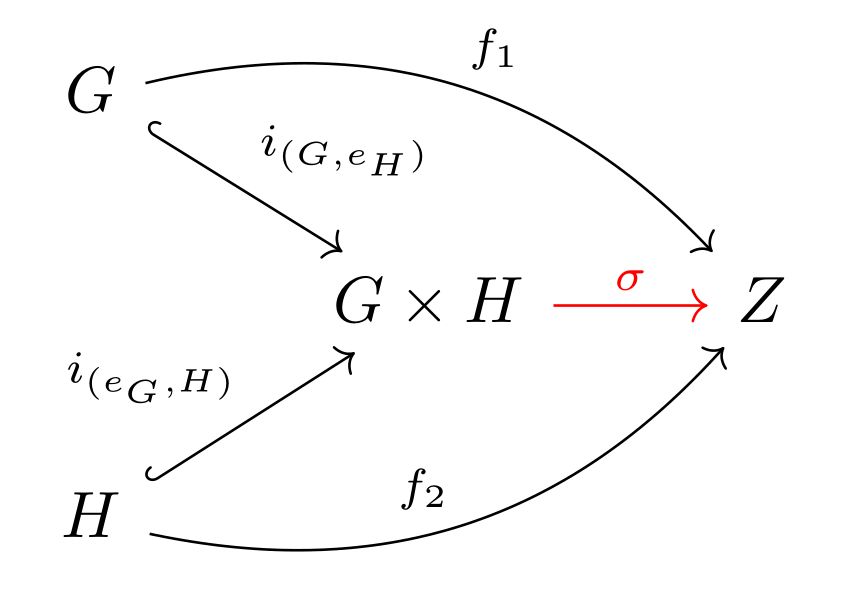The set products satisfy the coproduct property in the Abelian category.
The set product, where elements are pairs, is capable of acting as a co-product object in the category \( \cat{Ab} \). In other words, the following diagram commutes in \( \cat{Ab} \) where \( \sigma \) is uniquely determined by the rest of the diagram.
Commutative diagram
\( i_{\small{(G, e_H)}} \) and \( i_{\small{(e_G, H)}} \), the inclusion functions
The function \( i_{(G, e_H)} : G \to G \times H \) and \( i_{(e_G, H)} : H \to G \times H \) are special inclusion functions given by:
They place the input in either the first or second entry of a pair, leaving the other entry to be the identity element of the corresponding group, \( G \) or \( H \). The fixed identity entry allows the variable entry to inherit the group behaviour of the input. This insures that the inclusion functions satisfy the requirements to be group homomorphisms.
The morphism \( \sigma \)
It is not a matter of searching for \( \sigma \), for it's form was anticipated from the beginning.
\( \sigma : G \times H \to Z \) can be expressed precisely in terms of \( f_1, f_2 \) and \( \groupMul{Z} \):
The definition of \( \sigma \) follows (is forced from) from the constraints. What is interesting is that \( \sigma \) is actually possible! And only just. Can you remember why \( \sigma \) works in \( \cat{Ab} \) but not in \( \cat{Grp} \)?
\( G \times H \) as a co-product
\( G \times H \) is a valid group in both \( \cat{Grp} \) and \( \cat{Ab} \). It's group operation is the parallel application of the group operations from \( G \) and \( H \). In this sense, \( G \times H \) is not particularly interesting.
What is interesting is that \( G \times H \) satisfies the co-product property, even though it wasn't constructed for this purpose. The caveat here is that we have been careful to specify the behaviour of the inclusion functions to be used, \( i_{\small{(G, e_H)}} \) and \( i_{\small{(e_G, H)}} \). These inclusion functions are not standard inclusion functions, as the domain is not a subset of the co-domain.
\( \sigma \) as a group homomorphism
To be a group homomorphism, \( \sigma \) must satisfy the following equality, for any \( Z \):
Consider first the LHS:
Now the RHS:
For these two expressions to be equal, commutativity must be present.
\( \cat{Ab} \) vs. \( \cat{Grp} \)
\( \sigma \) being a group homomorphism is a critical requirement for \( G \times H \) to act as co-product.
Even if both \( G \) and \( H \) are commutative, we can find in the \( \cat{Grp} \) category a target group \( Z \) which is not commutative. With \( Z \) not being Abelian, we can't find a homomorphism from \( G \times H \) to \( Z \) in \( \cat{Grp} \). The universal property is only satisfied if there exists a unique morphism \( G \times H \to Z \) for all \( Z \), so any failure to find a morphism will prevent the universal property from being satisfied. This explains why \( G \times H \) cannot act as a co-product in \( \cat{Grp} \), even if \( G \) and \( H \) are commutative groups.
Example
The morphism \( \sigma \)
As an example, consider \( G = \{ a, b \}, H = \{ i, j, k \} \). The inclusion functions send elements of \( G \) to the highlighted column on the left and send elements of \( H \) to the highlighted row on the top. For the diagram above, the non-highlighted center section do not play a role in the actually set-function commutativity, as the elements are never mapped to by the inclusion functions; however, the center section does affects whether:
- \( G \times H \) forms a group
- \( \sigma \) forms a morphism in the category
both of which are requirements for the commutativity diagram to be valid diagram of morphisms between objects.
| H | |||||
|---|---|---|---|---|---|
| G | \( e \) | \( i \) | \( j \) | \( k \) |
|
| \( e \) | \( (e, e) \) | \( (e, i) \) | \( ( e, 2 ) \) | \( (e, 3) \) | |
| a |
\( (a, e) \) | \( (a, i) \) | \( (a, j) \) | \( (a, k) \) | |
| b | \( (b, e) \) | \( (b, i) \) | \( (b, j) \) | \( (b, k) \) | |
